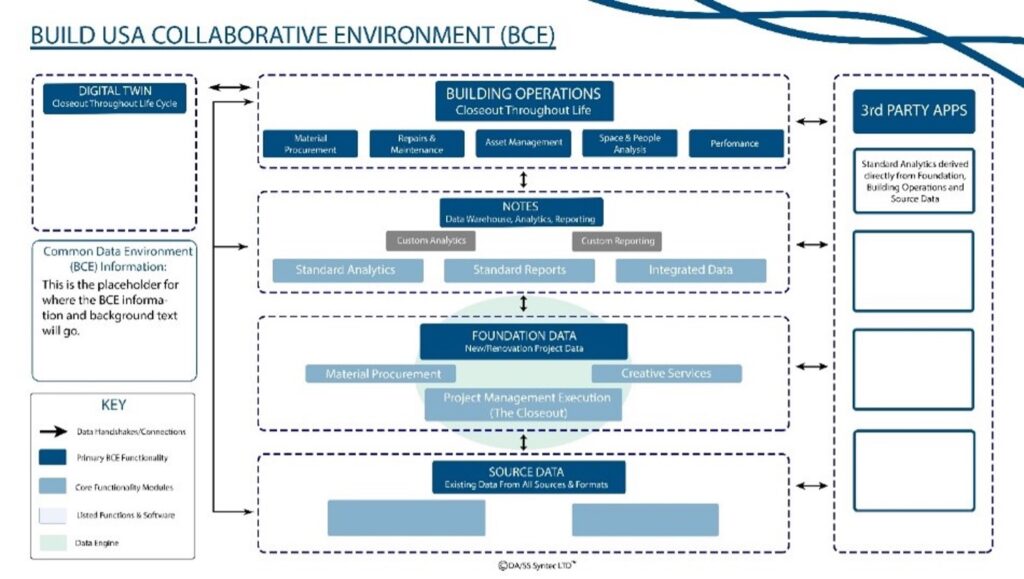Standards, Templates & Workflows (STW) +- Building collaborative Environment (BcE) * Common Data Environment (CDE) / Modular Buildings Built on Chassis (MB) * Construction Assembly Modules (CAMs) = BCE
STW +- BcE * CDE / MB * CAM= BCE
This post explores the nature of each component, – STW, BcE, and CDE – and the potential power that can be unlocked by combining them properly into a cohesive function:, STW +- BcE * CDE = BCE (much greater value)
———————————————————————————————————–
A few decades ago, the concepts of Standards, Templates, and Workflows (STWs) were just starting to be developed. At the time, building professionals thought about these concepts in isolation, and not in relation to other building workflows. For example, in the 1980’s we started developing standard details, notes, and sheet layouts. Over time, this standardization led to greater efficiency in the construction process and helped increase net profits. But we were not able to fully integrate these details and notes with specifications, line itemization, scheduling, and many other building workflows. Back then, it was a pipe dream that could not be supported by technology or financial budgets. Getting standards developed in-house by one company was difficult enough. To enforce standardization on two or more companies was beyond the capabilities of anybody at the time. Large companies tried to accomplish this by rolling up competitors and integrating them into their system. Brute force standardization did achieve some level of success for large-scale national and international building organizations. However, over the course of several years, the investment produced diminishing returns. All the systems were in-house, custom applications that could not keep up with market changes and improvements. Most of these systems only lasted for several years before they were replaced by off-the-shelf solutions that required only modest customization.
The importance of STWs in many creative areas of life was discussed in an earlier post, “Systems, Standards, Workflows & Modules 05/10/2020”.
As discussed in “BuildUSA-Optimized Building”, a long-standing challenge to creating effective building processes and products is the siloed nature of data and workflows. Identifying the minimum core STWs required for project team members to seamlessly share project information became the primary work of BuildUSA.
Simply put, we wanted to discover what STWs were required to successfully create
“Higher Quality, Higher Performance” buildings with shorter delivery times and lower costs.”
And figure out what systems needed to be implemented to consistently, accurately, and efficiently get the
“Right People” in the “Right Place” with the “Right Materials, Tools, and Information” at the “Right Time.” (In order to get the work completed correctly the first time).
These two questions initiated a research, development, and testing program that has lasted many years. Ultimately, this program resulted in the creation of the BuildUSA Collaborative Environment (BCE).
The iterative development process described in “BuildUSA-Optimized Building” was long. Initially, this work was integrated into active projects but ultimately, separating the workflow, process and technology development work, from current building project demands, became a necessity. Developing the BuildUSA Collaborative Environment (BCE) is complex and sophisticated. It needed to be developed in its own protected environment so real solutions could be truly resolved, and not just papered over with workarounds required to meet deadlines, due to active building projects time constraints.
Although the development of the BCE was complex, the implementation of the BCE by project teams will greatly simplify the design and execution of building projects.
- Standards, Templates, Workflows (STW):
STWs are the foundation stones upon which the BCE was developed. They support and enable the Prototype Initiative (PI), the Building collaborative Environment (BcE), Collaboratively Integrated Partner Organizations (CIPOs), and Optimized Building (OB). The current focus has been on developing the STWs that comprise the “Data Engine Component”, the heart of the BcE (see Figure 1 below). The Data Engine Component includes all the primary data creation and sharing authorizations necessary to conceive and execute a building project.
In brief, STWs are defined as follows:
“Standards” – Describe the rules and parameters that must be followed within multiple software environments to ensure data can be shared as seamlessly as possible.
“Templates” – Are specific settings, lists, views, and other required data structures that have been created in software files and allow data to be leveraged across the BcE and BCE platform.
“Workflows” – Are specific processes that determine how data and project requirements are created and shared across the BcE and BCE platform, and across different project phases and the building life cycle.
- Common Data Environment (CDE):
Concurrent with the development of the STWs various software platforms were analyzed to determine which could provide the best cloud-based structure and backbone to control how data files and transactions are created, shared, securitized, and authorized.
A CDE is a cloud-based digital platform that functions as a central repository for all project data. In addition to BIM data, this includes bid documents, contracts, registers, reports, schedules, specifications, and more.
The CDE provides:
- Enhanced collaboration – The CDE allows all project team members to access the most current information from any location and at any time. This facilitates teamwork and promotes a collaborative culture.
- A single source of truth – The CDE ensures a single source of truth for all project participants. Connecting project teams and project data in a unified environment leads to better decision-making. It also reduces errors, delays, and redundancies. Further, with all versions of all project data stored in a single place, no data is lost.
- Ensure data transfer – During the course of a project, data must be transferred from one project phase to another and from one team to another. Data is often compromised at handover points due to incompatibilities between files or applications, manual errors, or other issues. The CDE ensures successful data transfer across project phases.
- Strengthen security – The CDE stores data in a highly secure environment. It provides a full audit trail of the built asset and allows project managers to maintain strict control over who can access project content.
- Building collaborative Environment (BcE):
Once we developed the draft STWs and the CDE environment, we turned our attention to the actual building workflows, relationships, and data structures that need to operate within this cloud based digital environment, which we called the Build collaborative Environment (BcE). The primary functionality and supporting software were identified, and intensive testing ensued to determine if the draft STWs implemented, supported, and enhanced the process. It was no surprise that this testing was a process of discovery, and several iterations were required to define a coordinated set of STWs that could potentially support the sought-after seamless integration between the numerous software applications. The BcE is defined by the set of software and STWs that provide the functionality required to implement the project platform workflow described in figure 1 below.

Almost all the work to date has been focused on how data needs to be created within the data engine (green ellipse area in figure 1) to optimize how it can then be shared and leveraged within the Foundation Data section of the BcE. The Foundation data and workflows define all three segments of decision making that comprise a project: “Creative Services,” “Project Management-Execution,” and “Material Procurement.”
Initial testing has identified how this data can then be shared with the other five sections of the BcE: Notes, Building Operations, Source Data, Digital Twin, and 3rd Party Apps.
- Modular Buildings built on Chassis:
Modular construction is a significant characteristic of Optimized Building and the BCE. The initial schematic designs of the Optimized Ambulatory Building have sketched out how modular design and construction can be implemented within Structural, Mechanical/Electrical/Plumbing/Fire Protection, and Technology modular chassis. The goal is to develop a standardized building chassis that will work for each optimized building type. The potential benefits are multifold and occur in areas of the buildings that are felt by the human inhabitants but are rarely seen or directly interacted with. So, benefits and efficiencies can be maximized without negatively impacting user experiences due to lack of creative aesthetic options.
- Standardized Construction Assembly Modules (CAMs):
CAMs are a key feature of modular construction and offer an integrated approach to design that combines multiple trade disciplines into a single unit. CAMs are manufactured off-site, and then delivered and assembled on-site. CAMs can be manufactured and delivered in multiple formats, including:
- Panels
- Racks
- Boxes or pods
- Kit of Parts
- Groups
- Connections
In creating a new Optimized Building design, BUSA has been working with existing manufacturer/distribution networks who understand the changing nature of Building and are seeking to develop CAM products to position themselves for success in the future building marketplace.
All five of the elements described above, combine to create the “BuildUSA Collaborative Environment (BCE)”:
- Standards, Templates, Workflows (STW)
- Common Data Environment (CDE)
- Building collaborative Environment (BcE)
- Modular Buildings built on Chassis
- Standardized Construction Assembly Modules (CAMs)
When fully developed it will provide the technological backbone to support the full expression of Optimized Building. As discussed in “BuildUSA-Optimized Building” there are business components of Optimized Building that will evolve as Optimized Building develops volume, scale, and recognition. But the current focus is on the development of a robust and scalable BCE, capable of supporting a core group of commercial projects.
The integration of these components forms the technological backbone of the BuildUSA Collaborative Environment, supporting the expression of Optimized Building. The BCE is designed to be robust and scalable, capable of supporting a core group of commercial projects.
